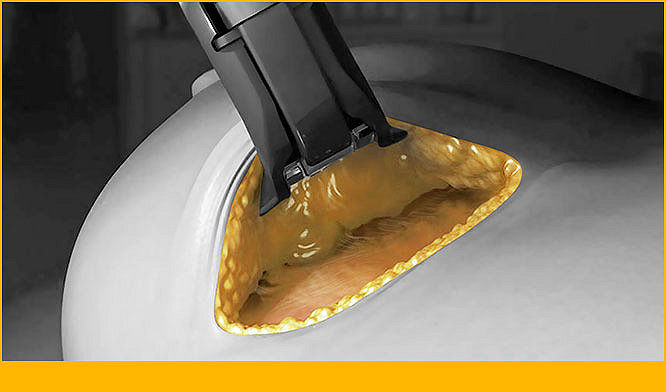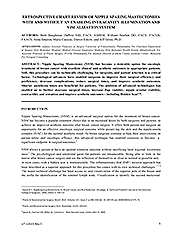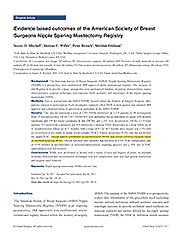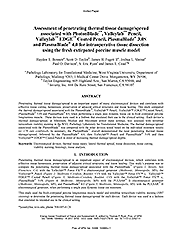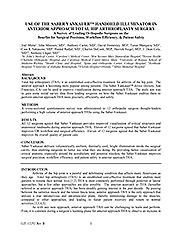Surgical access and visualization
Many surgical approaches require optimal illumination for visual access of tissues and other structures. This section will provide resources for enhancing visualization and improved access.
O.R. safety series: Enhanced visualization
Minimally invasive or minimal access procedures account for up to 40% of all surgical procedures today. While there are numerous patient benefits to these procedures, the approach does come with known hazards, such as poor lighting to access areas, potential for burn injuries and fires from light sources, retained surgical items and increased inefficiencies and time delays.
This program discusses the current data on medical errors and provides up to date evidence-based guidelines and strategies for prevention, including enhancing visualization of the operative field.
Learning objectives
- Describe the different types of medical errors in the O.R.
- Define the types of medical waste and how the O.R. is specifically impacted
- List the current practices and potential hazards associated with liquid waste
- Describe the risks associated with fluid waste management in the O.R.
- List the benefits of an effective and safe fluid waste management program in the O.R.
Retrospective chart revivew of nipple sparing mastectomies with and without an enabling intracavity illumination and visualization system
Authors: Beth Baughman DuPree, MD, FACS, ABIHM, William Scarlett, DO, FACS, FACOS, FAACS, Anna Smaron, Marie Cassese, Darren Eskow, Jeff Gross, PhD
Nipple Sparing Mastectomy (NSM) has become a desirable option for oncologic treatment of breast cancer with excellent clinical and aesthetic outcomes in appropriate patients. Still, this procedure can technically challenging for surgeons, and patient selection is a critical factor. Technological advances have enabled surgeons to improve their surgical efficiency and proficiency, decrease complications, reduce surgical times, and improve aesthetic outcomes. Shorter anesthesia times are beneficial for patients. The addition of advanced technologies has enabled us to further decrease surgical times, increase flap visibility, nipple areolar viability, contractility and sensation and improve aesthetic outcomes.
Avoiding damage to transvenous leads - a comparison of electrocautery techniques and two insulated electrocautery blades
Authors: Jeremiah Wasserlauf, MD, MS, Taiki Esheim BS, MBA, Natasha M. Jarett BS, Eric K.Y. Chan, PhD, Robert D. Schaller, DO, Fermin C. Garcia, MD, Bradley P. Knight, MD
Electrocautery (cautery) can damage transvenous cardiac device leads. The purpose of this study was to compare lead damage from an insulated cautery blade when used with several different techniques that included coagulation (COAG) versus cutting (CUT) mode, perpendicular active edge (active) versus parallel flat blade (flat) orientation (phase 1), and using one commercially available blade versus another (phase 1).
Evidence-based outcomes of the American Society of Breast Surgeons Nipple Sparing Mastectomy Registry
Authors: Sunny D. Mitchell, Shawna C. Willey, Peter Beitsch, Sheldon Feldman
Assessment of penetrating thermal tissue damage/spread
Authors: Haydon E. Bennett, Scott D. Taylor, James H. Fugett II, Joshua L. Shrout, Paul O. Davison, S. Eric Ryan, James E. Coad
Penetrating thermal tissue damage/spread is an important aspect of many electrosurgical devices and correlates with effective tissue cutting, hemostasis, preservation of adjacent critical structures and tissue healing.
Use of the saber yankauer™ handheld illuminator in anterior approach total hip arthroplasty surgery
A survey of leading orthopedic surgeons on the benefits for surgical precision, workflow efficiency & patient safety
Authors: Joel Matta, John Masonis, MD, Anthony Carter, MD, David Homesley, MD, Tarun Bhargava, MD, Cass K Nakasone, MD, Hamid Redjal, MD, Charles DeCook, MD, Herrick Siegel, MD, J. Deal Cole, MD, Anthony Unger, MD
Total hip arthroplasty (THA) is an established cost-effective treatment for arthritis of the hip joint. The anterior approach is becoming more popular among patients.
28996


